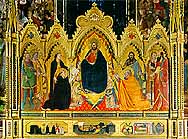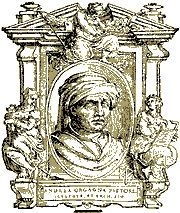Painter
active in Florence from 1343 to 1368
This was the nickname of a family of artists who lived and worked in the
late Gothic period; the best known member of the family, Andrea di Cione
Arcangelo (Orcagna in the local dialect) worked in Florence between 1343
(the year in which we can find him enrolled in the
Guild of physicians and chemists) and 1368 as a painter, sculptor and
architect. Andrea and his brothers Jacopo, Matteo and Nardo (who were really
more craftsmen than artists) owned the most important art workshop in Florence
of the period, also because all of Giotto's best students had died in the
1348 plague Maso di Banco, Bernardo Daddi. Andrea
Orcagna thus found himself having to take up the triple inheritance left
by an architect like Arnolfo di Cambio, a sculptor like Andrea Pisano and
a painter like Giotto, with the result that his work, which tended more
to be inspired by the style of Taddeo Gaddi than Giotto's "realistic" painting,
was to have a strong influence on the world of art in Florence during the
second half of the century.
His first known work of painting, and the only one that can be attributed to
him with any certainty, is the polyptych of Christ in glory between Saints, in
the Strozzi Chapel in Santa Maria Novella (1354-1357);
the artist's design of the painting is somewhat unusual (in that the positions
of the various figures completely ignore the divisions between the five sections
of the panel) but shows a return to the old-fashioned graphic style, with the
use of the Byzantine type outline, instead of concentrating on further investigation
into the volumes and shapes indicated by Giotto.
 A
A
.Orcagna, Poliptych of SS.Anunziata
This change in mental attitude is partly due to the religious crisis
that was unleashed by the terrible "Black Death" of 1346, and
partly to the different forms of research that were being experimented
by other schools of painting, as, for example, in Siena.
His most important work as a sculptor was instead the majestic Orsanmichele Tabernacle
(1349-59), which was designed to contain the Madonna of Mercy (1348), Bernardo
Daddi's last work. Built in the form of a tabernacle, it is really a marble
altar in pure Florentine-Gothic style, with coloured glass, bronze and polychrome
marble decorative elements and eight octagonal tiles in the lower part with Stories
of the Virgin which clearly show a renewed plastic interest and notable skill
in the organization of the figures in space. A large bas-relief at the rear of
the altar portrays the Death of the Virgin and her Assumption in heaven; this
is a really powerful work and anticipates the Florentine sculpture of the fifteenth
century: it should in fact be compared with the so-called Porta della Mandorla
or (Door of the Almond), carried out half a century later on exactly the same
theme by Nanni di Banco for the Cathedral, one of the first works of the Renaissance.
Orcagna also included his own self-portrait (the figure with the covered head
on the extreme right, below the tree) among the many personalities crowding his
interpretation of the Death of the Virgin.
In 1359-62 Andrea and his brother Matteo were summoned to Orvieto to direct the
work on the Cathedral there but Andrea was already back in Florence by 1364 and
busy working on the decoration for the facade of Santa
Maria del Fiore. The last known record of him is dated 1368, when he painted
a Madonna (today lost) for Orsanmichele. Most of the frescoes he
carried out in Santa Croce, mentioned by Ghiberti,
are also lost.

A.Orcagna, Poliptych in S.Maria
Novella
Orcagna painted a magnificent painting of the Last Judgement on the
righthand wall of this Basilica: the detail of the Triumph of Death (now
in the church's Museum) gives an extremely good idea of the way people
felt about the frailty of human life and the fear that must have pervaded
the city immediately after the "Black Death", which had eliminated
more than half of the population. An interesting detail is that the man
in the group of three observing the eclipse of the sun, and who is turning
away covering his eyes with one hand as if blinded by the light, is probably
Taddeo Gaddi. According to Vasari, Orcagna also
painted the frescoes, again of the Triumph of Death and the Last Judgement,
in the Graveyard at Pisa; today, however, these two works are attributed
to Francesco Traini instead.
Last but not least, he was also an architect, designing the Loggia in Piazza
della Signoria, later called the Loggia dei
Lanzi in the sixteenth century; the actual construction was however carried
out after his death (between 1376 and 1382) by his students Benci di Cione and
Simone Talenti.
His brother, Jacopo di Cione, also a painter, died sometime after 1398; his career
was almost always overshadowed by the head of the family, whose style and donors
he was to inherit. His works include the Triptych of St. Matthew (1369, Uffizi),
a Coronation of the Virgin, today in London, and a magnificent Altarpiece carried
out for the Church of San Pier Maggiore.
Nardo di Cione, who died in Florence in 1366, is instead well known for having
worked with his brother Andrea on the frescoes in the Chancel at Santa
Maria Novella and on those in the naves at Santa
Croce, as well as having carried out the important cycle of the Last Judgement,
Hell and Paradise in the Strozzi Chapel at Santa
Maria Novella; the latter still show the influence of Giotto's painting but
also strongly reflect that of the Sienese school because of the static beauty
and decorative brilliance used for the figures.

